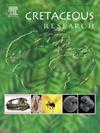Palaeoenvironmental interpretation and isotope stratigraphy of the Campanian–Danian successions in the Zagros Foreland Basin (Kabir Kuh, Lurestan, Iran)
IF 1.7
3区 地球科学
Q1 GEOLOGY
引用次数: 0
Abstract
The successions of the Gurpi Formation and the lower Pabdeh Formation were examined through analyses of lithology, sequence stratigraphy, stable isotope stratigraphy, and ichnofossils in the Jahangir Abad and Abhar sections of the Kabir Kuh anticline within the Lurestan Zone. Stratigraphic correlation with the well-dated Gandab section, located within the same anticline, indicates a late Campanian to early Danian age for these successions. This correlation further confirms the presence of notable carbon isotope excursions associated with the Campanian-Maastrichtian Boundary Event (CMBE) and Mid-Maastrichtian Event (MME). Field observations, along with sedimentological and paleontological analyses, suggest that the Kabir Kuh area was situated within the fore-bulge of the Zagros foreland basin during the Late Cretaceous. Changes in lithology, fossil content, and ichnofacies indicate a significant decrease in water depth at the end of the Campanian and the beginning of the Maastrichtian. This interval contains shallow marine macrofossils, including oysters (mainly Lopha), benthic foraminifers, and fossil debris traces, indicative of a high-energy environment. In contrast, shallow-water facies are not recorded within the middle and late Maastrichtian sequences. These sequences are composed of pelagic mud-dominated facies containing deep-sea ichnofossils, indicating a rapid increase in water-depth during the middle–late Maastrichtian. The observed late Campanian to early Maastrichtian shallowing is associated with the development of the Zagros fore-bulge, while the subsequent deepening and significant sediment deposition during the mid to late Maastrichtian are attributed to the subsidence of the basin. This research re-evaluates and refines the existing sequence stratigraphic and sedimentary models of the Zagros foreland basin, offering new perspectives on its geological evolution.
伊朗扎格罗斯前陆盆地坎帕系-达尼系古环境解释及同位素地层学研究
通过岩石学、层序地层学、稳定同位素地层学和鱼化石分析,对勒勒斯坦地区Kabir Kuh背斜Jahangir Abad和Abhar剖面的Gurpi组和下Pabdeh组进行了研究。与位于同一背斜内的甘达布剖面的地层对比表明,这些序列的年龄为晚坎帕世至早丹尼世。这种相关性进一步证实了与坎帕尼亚-马斯特里赫特边界事件(CMBE)和中马斯特里赫特事件(MME)相关的显著碳同位素偏移的存在。野外观测以及沉积学和古生物学分析表明,Kabir Kuh地区在晚白垩世时期位于扎格罗斯前陆盆地的前隆起中。岩石学、化石含量和鱼相的变化表明,坎帕尼亚纪末和马斯特里赫特纪初的水深明显下降。该层段含有浅海大型化石,包括牡蛎(主要是Lopha)、底栖有孔虫和化石碎屑痕迹,表明其为高能环境。而在中晚期马斯特里赫特层序中没有浅水相的记录。这些层序由含深海鱼化石的远洋泥质为主相组成,表明马斯特里赫特中晚期水体深度迅速增加。坎帕尼亚晚期至马斯特里赫特早期的浅化与扎格罗斯前隆起的发育有关,而马斯特里赫特中晚期的进一步加深和大量沉积则与盆地的沉降有关。本研究对扎格罗斯前陆盆地现有层序地层和沉积模式进行了重新评价和完善,为其地质演化提供了新的视角。
本文章由计算机程序翻译,如有差异,请以英文原文为准。
求助全文
约1分钟内获得全文
求助全文
来源期刊

Cretaceous Research
地学-地质学
CiteScore
4.10
自引率
19.00%
发文量
235
审稿时长
12 weeks
期刊介绍:
Cretaceous Research provides a forum for the rapid publication of research on all aspects of the Cretaceous Period, including its boundaries with the Jurassic and Palaeogene. Authoritative papers reporting detailed investigations of Cretaceous stratigraphy and palaeontology, studies of regional geology, and reviews of recently published books are complemented by short communications of significant new findings.
Papers submitted to Cretaceous Research should place the research in a broad context, with emphasis placed towards our better understanding of the Cretaceous, that are therefore of interest to the diverse, international readership of the journal. Full length papers that focus solely on a local theme or area will not be accepted for publication; authors of short communications are encouraged to discuss how their findings are of relevance to the Cretaceous on a broad scale.
Research Areas include:
• Regional geology
• Stratigraphy and palaeontology
• Palaeobiology
• Palaeobiogeography
• Palaeoceanography
• Palaeoclimatology
• Evolutionary Palaeoecology
• Geochronology
• Global events.
 求助内容:
求助内容: 应助结果提醒方式:
应助结果提醒方式:


